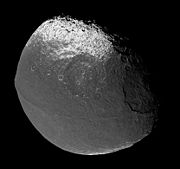
Cassini Regio
Encyclopedia

Saturn
Saturn is the sixth planet from the Sun and the second largest planet in the Solar System, after Jupiter. Saturn is named after the Roman god Saturn, equated to the Greek Cronus , the Babylonian Ninurta and the Hindu Shani. Saturn's astronomical symbol represents the Roman god's sickle.Saturn,...
's moon Iapetus
Iapetus (moon)
Iapetus ), occasionally Japetus , is the third-largest moon of Saturn, and eleventh in the Solar System. It was discovered by Giovanni Domenico Cassini in 1671...
. It is named after Giovanni Cassini
Giovanni Domenico Cassini
This article is about the Italian-born astronomer. For his French-born great-grandson, see Jean-Dominique Cassini.Giovanni Domenico Cassini was an Italian/French mathematician, astronomer, engineer, and astrologer...
, the discoverer of Iapetus; 'Regio
Regio
Regio is the Latin word for ‘region’ and the Italian word for ‘royal’It may refer to:*Regio - in planetary geology, a large area of a planet or moon that is strongly differentiated in colour or albedo**A regio of Venus:...
' is a term used in planetary geology
Planetary geology
Planetary geology, alternatively known as astrogeology or exogeology, is a planetary science discipline concerned with the geology of the celestial bodies such as the planets and their moons, asteroids, comets, and meteorites...
for a large area that is strongly differentiated in colour or albedo
Albedo
Albedo , or reflection coefficient, is the diffuse reflectivity or reflecting power of a surface. It is defined as the ratio of reflected radiation from the surface to incident radiation upon it...
from its surroundings. The brighter half of Iapetus is called the Roncevaux Terra
Roncevaux Terra
Roncevaux Terra is the name given to the highly reflective side of Saturn's moon Iapetus. The other half of Iapetus, named Cassini Regio, is extremely dark...
.
The nature of the material that caused the extensive discoloration of Cassini Regio is not known, but it appears to be quite thin. It may be the result of cryo-vulcanism
Vulcanism
Vulcanism may refer to* Volcanism or volcanic activity.* Plutonism, a scientific theory of the Earth....
, a spattering of material from outer moons, or residue left by the sublimation of brighter ice. The NASA
NASA
The National Aeronautics and Space Administration is the agency of the United States government that is responsible for the nation's civilian space program and for aeronautics and aerospace research...
Cassini
Cassini-Huygens
Cassini–Huygens is a joint NASA/ESA/ASI spacecraft mission studying the planet Saturn and its many natural satellites since 2004. Launched in 1997 after nearly two decades of gestation, it includes a Saturn orbiter and an atmospheric probe/lander for the moon Titan, although it has also returned...
probe flew by Iapetus on 2007 September, and the images are helping to clarify the nature of Cassini Regio. For more details, see the main article on Iapetus
Iapetus (moon)
Iapetus ), occasionally Japetus , is the third-largest moon of Saturn, and eleventh in the Solar System. It was discovered by Giovanni Domenico Cassini in 1671...
.
In 2004, it was discovered that a 1,300 km long ridge of 20 km (12 miles or 60,000 ft.) high mountains runs down the centre of Cassini Regio, almost perfectly following Iapetus's equator. The origin of this extremely unusual feature is as yet unknown.

